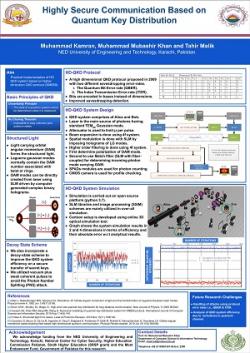Highly Secure Communication Based on Quantum Key DistributionMuhammad Kamran, Prof. Dr. Muhammad Mubashir Khan and Tahir Malik Secure exchange of cryptographic keys is extremely important for any communication system where security and privacy of data are desirable. Although classical cryptographic algorithms provide computationally secure methods for secret key exchange, quantum key distribution (QKD) provides an extraordinary means to this end by guaranteeing unconditional security. Any malicious interception of communication by a man-in-the-middle on a QKD link immediately alerts the sender and receiver by introducing an unavoidable error rate. Higher-dimensional QKD protocols such as KMB09 exhibit higher eavesdropping error rates with improved intrusion detection but their practical implementation is still awaited. In our research, we propose the design and implementation of the KMB09 protocol using Laguerre–Gaussian orbital angular momentum to demonstrate and highlight the advantages of using dynamic spatial modes in the QKD system. A complete error-rate analysis of the KMB09 protocol implementation is presented with two different types of eavesdropping error rates. Furthermore, we also demonstrate the decoy-state method to show the robustness of the protocol against photon-number-splitting attacks. |
|
Enhancing Packet Delivery in Intelligent Transportation System (ITS)Abdul Karim Kazi, Prof. Dr. Shariq Mahmood Khan Many people worldwide are killed or injured every day due to traffic accidents. These deaths and injuries could potentially be avoided if Vehicular adhoc network (VANET) is used. Intelligent Transportation Systems (ITS) applications can benefit greatly from VANET's support capabilities, which is why academics and researchers are interested in it. VANETs are a cost effective means of providing communication amongst vehicles. Each vehicle on the road will be equipped with a wireless communication capability to facilitate the interconnection of wireless networks. A vehicle can receive or forward messages from nearby vehicles linked to the same network even if no supporting infrastructure is present. As a result, drivers will be able to keep track of changes in traffic conditions and other travel-related information as they are made accessible. VANETs have certain advantages in comparison to mobile adhoc networks (MANETs), including enhanced computational power, increased transmission power, and a degree of projected mobility. The performance and quality of VANET generates major technical issues in existing system, which must be monitored to efficiently organize these types of connections. Frequent changes in network topology as well as the increased mobility of the network topology are likely to be the most difficult problems to solve. When cars change their data rates or tracks in VANETs, the topology of the network also changes. Normally, these modifications are not planned ahead of time and are entirely dependent on the road conditions and the actions of the drivers. VANET communication requires a routing mechanism that is both dependable and accurate in representing the topological needs of the network's nodes. Given that cars are driven at high speed on roads, disruptions in terms of data distribution facilities as a result of frequent interruptions in the connection are likely. The proposed research project is based on enhancing the Packet Delivery Ratio and reducing the routing overhead, so that the optimized network performance can be achieved. |
SDN-IBN Forensics ToolkitDr. Muhammad Faraz Hyder Software Defined Networking (SDN) and Intent based Networking (IBN) are emerging networking paradigms. These are running at the network backbone of all major Cloud Service Providers, Telecom Operators, Internet Service Providers, and large enterprises. SDN / IBN networks are vulnerable to Flooding Attacks, Identity Spoofing, Side-Channel Attacks, DoS, API Exploitation, Memory Scraping, Remote Application Exploitation, Traffic Sniffing Attacks, etc. Due to the rapid increase in the rate of attacks, there is a need to have a forensics investigation mechanism for IBN and SDN at the service provider level. This product is useful for performing the forensics investigation at the application, control, and data planes of SDN. The toolkit comprises of log collection and analysis modules. |
|
|
Prof. Dr. Shehnila Zardari This is a web application which could help easily diagnose diseases in plants using Machine Learning all on the web, powered by TensorFlow JS. Our solution of automated early disease detection is based on an artificial neural network, which is now the most robust technique for image classification. The main advantages of our solution include high processing speed and high classification accuracy. A plant disease recognition system can work as a universal detector, recognizing general abnormalities on the leaves, such as scorching or mold. However, our further research is related to precise recognition of particular diseases. After extensive training on diverse datasets our machine learning model will be capable of distinguishing a large number of different diseases. Issues Addressed: Computer vision and machine-learning solutions offer great opportunities for the automatic recognition of sick plants by visual inspection of damaged leaves. Crop diseases are an important problem, as they cause serious reduction in quantity as well as quality of agriculture products. An automatic plant-disease detection system provides clear benefit in monitoring of large fields, as this is the only approach that provides a chance to discover diseases at an early stage. Our solution of automated early disease detection is based on an artificial neural network, which is now the most robust technique for image classification. The main advantages of our solution include high processing speed and high classification accuracy. A plant disease recognition system can work as a universal detector, recognizing general abnormalities on the leaves, such as scorching or mold. However, our further research is related to precise recognition of particular diseases. After extensive training on diverse datasets our machine learning model will be capable of distinguishing a large number of different diseases. |
Automatic TV Commercial Detection:Prof. Dr. Najeed Ahmed Khan and Dr. Waseemullah Due to rapid enhancement in digital media, a lots of information including video ads are available for community entertainment and officially used. Analysis of targeted TV commercials is tedious due enormous amount of data. A novel framework is presented by which statistics of any targeted (Pakistani) TV commercial can be automatically analyzed. The approach works with segment semantic videos and detect commercials (ads) in a broadcasted TV transmission. The proposed technique uses image processing technique combines SURF features and color Histogram in a weighted combination framework resulting in detecting individual TV ads from the transmission after segmenting semantic videos. Thus, better results are achieved. The proposed framework is designed for TV transmissions those who do not use black frame technique between the ad and non-ad part of the transmission and is commonly used in Pakistani TV channels transmission. The television transmission standards in Pakistan are different from those that are used in other countries of the world. The framework used unsupervised technique to segment the videos.. |


